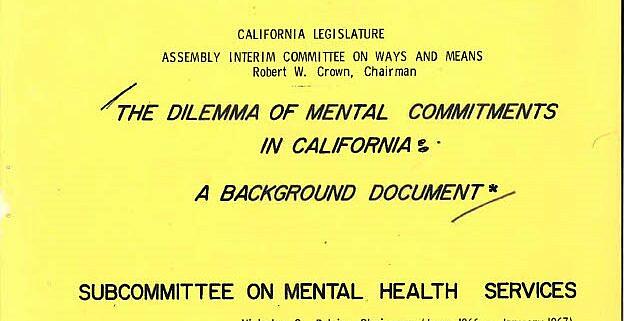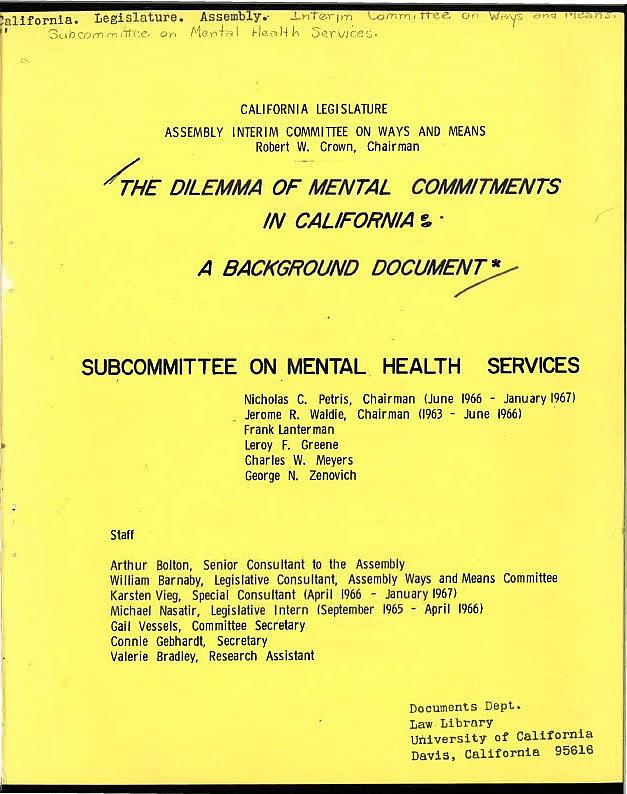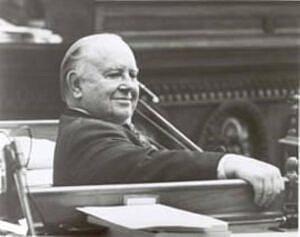The forgotten report that upended mental health care in California
The story was originally published in Capitol Weekly with support from our 2024 California Health Equity Fellowship.

“The Dilemma of Mental Commitments in California.”
Photo by UC Davis Library
Imagine that you’re confused, wearing hospital-issued pajamas, and seated before a judge who has convened a hearing focused on your mental state.
A physician, a cop and maybe a member of your family have gathered in the conference room and describe how you’ve been acting. Although your mind is spinning, you try to explain yourself.
The hearing lasts 4 minutes, 42 seconds. The judge, who seems to be well-meaning and compassionate, rules that you should be sent away for your own good. There is no appeal. Armed officers drive you to your destination, a crowded state asylum far from where you’ve been living.
Once there, your room will be a dormitory and your bed will be a few inches from beds on either side of yours, and you will have lost more rights than a felon who is doing hard time.
You must forfeit any public office or professional license. You cannot receive unopened mail, mail a private letter, or talk alone by phone. You cannot possess a driver’s license or gun. Nor can you vote, sign a contract, marry, or procreate. If you bridle against such restrictions, you might be bound in leather restraints and strapped to a bed.
That is how a group of young legislative aides, empowered by California Assembly leaders who had established a special subcommittee focused on state hospitals, described the mental health care system and commitment process they encountered in the middle 1960s.
If there was any single event that sped the emptying of state asylums in California in the late 1960s and early 1970s, it was the publication of these staffers’ 204-page report entitled, “The Dilemma of Mental Commitments in California.”

The Dilemma of Mental Commitments in California
The report was an exposé, a philosophical treatise, and a policy prescription. It became public on Nov. 24, 1966, three weeks after Ronald Reagan defeated Democratic Gov. Edmund G. “Pat” Brown, and six weeks before Reagan took the oath of office at the Capitol in Sacramento.
“The Dilemma of Mental Commitments in California” is all but forgotten today, existing on a few library shelves. There’s no digital version. But it framed the legislative debate in 1967 and led to one of the most consequential pieces of legislation ever signed in California, the Lanterman-Petris-Short Act.
The bill, which passed on the final day of the legislative session in August 1967, granted state hospital patients basic civil rights including the right to refuse treatment.
Its proponents called it the “Magna Carta” for people with severe mental illness. Reagan, having been assured that the bill would cost little or no additional money, signed the bill with no fanfare on Sept. 2, 1967.
Almost 60 years later, as California elected leaders overhaul the mental health care system, the dilemma report and the legislation it helped bring about is a part of the origin story that helps explain how we got to this point, where 38 percent of state prison inmates and up to 80 percent of California’s 67,000 chronically homeless individuals are diagnosed with a mental illness.
Although some of it is dated, the report reflects facets of the debate that go on to this day about how best to treat and care for people with severe mental illness.
***
As the report’s authors saw it, the dilemma of mental commitments was that the system had two objectives: “Individual health and public safety.”
“While these goals need not always conflict, differences in emphasis have engaged the medical and legal professions in a continuous debate over which is more important, ‘civil liberties’ or ‘treatment’ considerations,” the authors wrote.
“The basic difficulty stems from the attempt to combine two very different social objectives–custody of the dangerous and treatment of the sick–in a single system. The result is a system in which it is difficult to achieve fully either individual health or public safety goals.”
At multiple points, the report reflected the authors’ ambivalence about the concept of mental illness, citing in one passage Thomas Szasz, a psychiatrist whose most lasting work was the 1961 book, “The Myth of Mental Illness.”
Echoing a theme of that book, the authors wrote that “when a person’s behavior is labeled ‘mental illness,’ those who do the labeling are guided by their own conceptions of what is normal and abnormal.”
“Madness, like beauty, may exist in the eye of the beholder,” they wrote.
If sections of the report reflected a Romanized view of mental illness, the authors also exhibited a clear-eyed view that former patients, and people who in an earlier day would have been relegated to state hospitals, could not be cast adrift.
The report recommended that California create a network of what it called emergency crisis units, staffed by social workers, nurses, psychologists, physicians, and others who would respond at any hour to assist people in the midst of psychiatric breaks.
That recommendation went unheeded–in part at the insistence of John Schmitz, a far-right state senator and John Birch Society member who was in a position to derail the bill if he didn’t get his way.
Sacramento Mayor Darrell Steinberg spent much of his nearly eight years as mayor confronting homelessness and 14 years before that in the Assembly and state Senate seeking to improve California’s mental health care system.
After reading the report and its recommendation for a network of crisis centers, Steinberg asked a basic question:
“What if? What if that had happened? There would have been a lot less suffering and we would have helped many more people live their best lives.”
***
The report would not have come about without Assembly Speaker Jesse Unruh. A giant in the history of the legislature, Unruh was the son of an illiterate Texas sharecropper, who came to

Assembly Speaker Jesse Unruh
Photo via California Blue Book
California after World War II, went to University of Southern California on the G.I. Bill, and won an Assembly seat on his third try in 1954, representing Inglewood and an area south of downtown Los Angeles.
Renowned for his voracious appetites for food, liquor, and women, and for his partisanship, people called him “Big Daddy,” though not to his face.
Unruh had big ambitions for himself, for the Assembly and for policy. He pushed through the landmark Unruh Civil Rights Act of 1959 and promoted a 1966 ballot measure that transformed the part-time legislature, which had been subservient to the governor, into a full-time co-equal branch of government.
Unruh also took on the mission of overhauling the state hospital system, following the lead of President John F. Kennedy for whom he had deep affinity. Unruh had been JFK’s California campaign chairman in 1960, as he was for Robert F. Kennedy; Unruh was at RFK’s side when the presidential candidate was assassinated at the Ambassador Hotel in 1968.
President Kennedy called for a new system of community care for people with mental illness and developmental disabilities in 1963. That year, Unruh created the Assembly Mental Health Services Subcommittee of the Assembly Ways & Means Committee to study the system of care for people with mental illness and developmental disabilities.
He appointed one of his closest allies, Assemblyman Jerome R. Waldie; along with Democratic Assemblyman Nicholas C. Petris, a rising star and Stanford-educated lawyer; and Assemblyman Frank Lanterman, a Republican from the hilly Los Angeles suburb of La Cañada Flintridge who had showed an interest in the issue beginning in his first year in office, 1951.
Waldie was elected to Congress in 1966 and gained notoriety for his opposition to the Vietnam War and early advocacy of the impeachment of Richard Nixon over the Watergate scandal. Petris won a Senate seat in 1966, where he served for another 30 years. That left Lanterman. Although Unruh was a Democrat, the Assembly speaker entrusted the chairmanship to the subcommittee’s lone Republican, Lanterman.
Arthur Bolton, among Unruh’s most trusted aides, was the lead staffer on the subcommittee and the report’s lead author. Bolton was appalled at the conditions he found, as evidenced by a report stamped “confidential” he wrote in July 1964 after visiting DeWitt State Hospital, an asylum east of Sacramento that was shuttered in 1972.
It was, he wrote, “worse than I expected.”
Staff had patients engage in “industrial therapy” by having them work in the hospital’s laundry for no pay in summer heat of at least 100 degrees.
“It is hard, heavy work. Some of the laundry bags weigh over 100 pounds,” he wrote in his report to committee members.
Noting that DeWitt staff made liberal use of restraints, Bolton failed to hide his sarcasm when he questioned the “therapeutic value of being stripped naked and tied to a bed.”
“The patient in this instance was not raving wild. He was just lying there, looking miserable, old, and feeble.”

Jerome Waldie
Photo via U.S. House of Representatives
Four weeks before his visit, Bolton wrote, a psychiatric technician had been arrested on homicide charges for the death of a patient. One of the doctors, “said to be an alcoholic,” prescribed an enema for what he thought was a patient’s bloated stomach. As it happened, the patient was pregnant.
The following year, 1965, the subcommittee produced legislation, which was signed into law by Gov. Pat Brown, creating the first two of what would become a statewide system of regional centers to care for people with developmental disabilities.
Over the years, care provided by those 21 centers replaced state hospitals that once housed more than 10,000 people with Down Syndrome, autism, cerebral palsy, and other developmental disabilities.
The subcommittee next turned its attention to psychiatric asylums, facilities that at their height in 1959 at the start of Brown’s time as governor housed 37,000 people with schizophrenia and other psychoses, brain damage, dementia, alcoholism, and drug addiction.
Bolton and his team’s most dramatic finding – one that became the focus of news stories across the state – dealt with the perfunctory nature of hearings that led to state hospital commitments:
“The subcommittee’s survey of California commitment courts found that the average length of commitment hearings in this state was 4.7 minutes. One third of them took less than two minutes each.”
The pain of the patients, their loss of freedom and rights, and the humiliation of being sent to asylums clearly elicited the authors’ sympathies.
“[T]he citizens who come before the court for three or four minutes must be completely bewildered. Many must believe that they are being incarcerated for terrible deeds.”
More than a fourth of the persons objected to their court-ordered commitment, they wrote, “often by weeping or by begging not to be sent away.”
The authors of the report noted that the cavalier commitment process might have been justified if the hospitals fulfilled their mission. But they didn’t. The prognosis for state hospital patients was “poor” or “guarded” for 61 percent of state hospital patients, the report concluded.
After detailing the many problems and issues with the system, the authors offered a summary that could double as an indictment:
“Despite all these uncertainties; despite the problems of definition, identification, and prediction; despite the questionable value of certain treatment programs.
“[A]nd despite the civil liberties problems, the general public, its elected representatives and civil servants have perpetuated the commitment court and mental hospital system as a means of disposing of a variety of disagreeable social problems.”
The report became news across the state.
On Nov. 28, 1966, a UPI story appeared on the front page of what was the largest circulation afternoon paper in the state, the Los Angeles Herald Examiner:
“Thousands of Californians are ‘erroneously’ and ‘inappropriately’ committed to state institutions involuntarily after court hearings which lasted an average of 4.7 minutes.”
On that same day, the San Francisco Chronicle reported on its front page that “thousands of Californians are ‘still inappropriately committed to state mental hospitals, that the commitment proceedings are permeated by a ‘presumption of insanity’ and that the aver time of the court hearing is only 4.7 minutes.”
Less commented upon were the recommendations.
***
The authors clearly had given thought to how people who once were locked away in asylums should be treated once they returned to their hometowns.
The main recommendation was that the state create emergency service units to provide services to mentally disordered persons voluntarily, “quickly without stigma or legal disabilities.”

Rep. Frank Lanterman
Photo via the Lanterman Historical Museum Foundation
People could receive emergency counseling, suicide prevention, or medical, legal, or social services. Participants could choose their own doctors and would be “free to terminate treatment at any time.”
In some instances, people could be held involuntarily in hospitals but only if a doctor concluded that the person was gravely disabled or “appears to be an immediate threat to other persons and has refused to accept treatment on a voluntary basis.”
Even then, the time spent in locked wards would be limited to a few weeks. Importantly, the facilities would be expected to “actually provide treatment.”
“The Dilemma of Mental Commitments in California” rightly predicted that once the commitment court system was done away with, there would be a rapid decline in state hospital census.
“State hospitals as we now know them, will no longer exist,” the report said.
With the report completed, Petris and Lanterman set about writing their legislation, and on May 1, 1967, they convened a press conference to announce its introduction.
A press release handed out at the time said Assembly Bill 1220 was “the result of one of the most extensive studies ever conducted by a state legislative body in the United States.” The statement said 4,000 Californians had requested the report and it was being used as a text in several colleges and universities.
As recorded by KOVR television in Sacramento and provided by the Center for Sacramento History, Petris opened the press conference by describing the proposal:
“Every county in the state will create a local committee which will be required to take full advantage of all mental health facilities in the county both public and private … The accent is going to be on voluntary treatment rather than involuntary treatment.”
“What you ought to keep in mind,” Lanterman added, “is that the present system of commitment virtually says anyone who says this patient is in need of treatment, then can be committed indefinitely into a state hospital. This is perhaps one of the most drastic deprivations of a person’s liberty possible under the law. … It is indefensible.”
And then the logrolling began.
